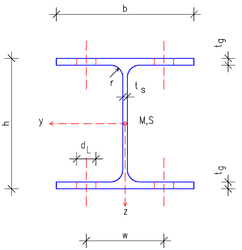Wide flange beam
Wide flange girders , also called Peiner girders , are steel girders that are used in steel construction , e.g. B. hall construction, bridge construction, industrial and commercial construction can be used. HEA (old: IPBl), HEB (old: IPB), and HEM (old: IPBv) are the typical trade names for wide-flange beams with DIN profiles.
meaning
Building with steel girders is characterized by flexibility in the design (combination of steel and glass ) as well as fast and cost-effective construction (due to the possibility of prefabrication in the steel construction production). Steel girders are mainly made from scrap and, after their use, can also be recycled as scrap to make new steel products.
standardization
Section steel according to EN 10034 or DIN 1025-3 (HEA), DIN 1025-2 (HEB), DIN 1025-4 (HEM)
The following materials are predominantly used as materials according to EN 10025: 1990 + A1: 1993 for the wide flange beam (as well as the other commercially available steel beams IPE and UNP ):
| EN 10025: 1990 | old designation according to DIN 17100 | new standard EN 10025-2: 2004 |
| S235JR | St 37-2 | not applicable |
| S235JRG2 | RSt 37-2 | S235JR |
| S355J2G3 | St 52-3U | not applicable, but probably as a new commercial standard S355J2 |
The new standard EN 10025-2: 2004, which no longer permits non-killed steels , has been solely valid since September 1, 2006 after a transition phase in which the old and new standards were in force. From now on only steels according to the new standard may be brought into circulation. The corresponding implementation in the state building regulations has been completed. The previous Ü mark is being replaced by the CE mark .


